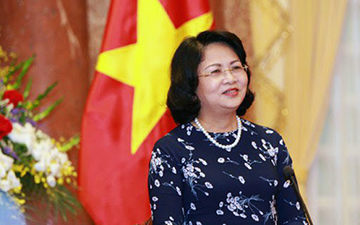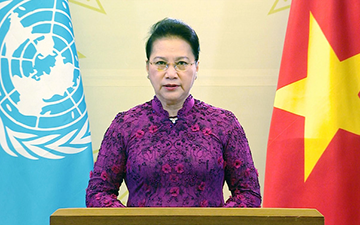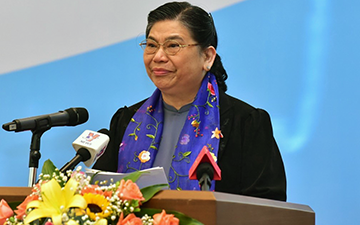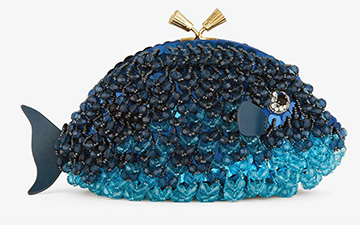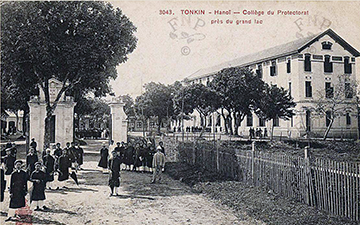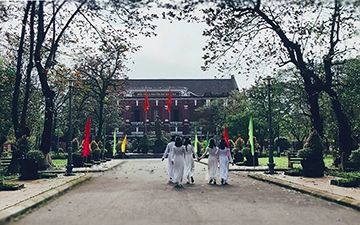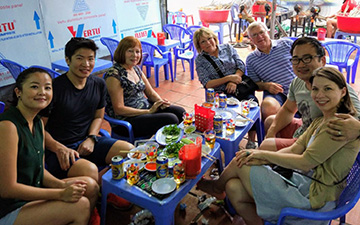WOMEN'S CULTURE IN VIETNAM
“When the enemy is at the gate, the woman goes out fighting” (Giặc Đến Nhà, Đàn Bà Phải Đánh). Hundreds of thousands of Vietnamese females sacrificed their youth by answering “aye” to the call of “the country needs you,” enrolling and going to the front in order to accomplish the hardest tasks. A good many of them had not yet had time to savor the taste of love before falling into the oblivion of history. Those who survived and are still alive today live in such a state of moral and material abandonment that they often have had to form a community within the community (a village) to cope with the general indifference. The history of these women and this movement is yet to be written.
The role of women in Vietnam (vai trò của phụ nữ ở Việt Nam) was subject to many changes throughout the history of Vietnam (có nhiều thay đổi trong suốt lịch sử việt nam). They have taken on varying roles in society, including warriors, nurses, mothers and wives. 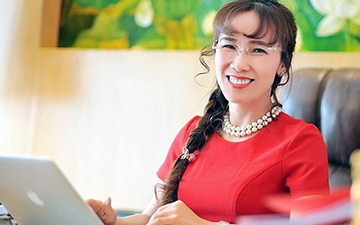 There have been many advances in women's rights in Vietnam, such as an increase in women representation in government, as well as the creation of the Vietnam Women's Union (Hội Liên Hiệp Phụ Nữ Việt Nam) in 1930. The role of women in warfare and outside the home continued to increase throughout the 20th century, especially during the Indochina Wars (Chiến Tranh Đông Dương). During and after the Vietnam War, the ruling Communist Party of Vietnam made efforts to increase women's rights, equity, and representation in government (quyền công bằng và đại diện trong chính phủ của phụ nữ). This included the creation of job quotas (điều này bao gồm sự sáng tạo việc làm cho mỗi người) during the 1960s, which required that women occupy a certain percentage of jobs in different sectors. Women's rights have continued to increase in contemporary Vietnam (Việt Nam hiện đại), and women have increasingly held leadership positions. Vietnam has one of the highest female labour-force participation rates in the world and ranked the second most women in senior management among Asian countries.
There have been many advances in women's rights in Vietnam, such as an increase in women representation in government, as well as the creation of the Vietnam Women's Union (Hội Liên Hiệp Phụ Nữ Việt Nam) in 1930. The role of women in warfare and outside the home continued to increase throughout the 20th century, especially during the Indochina Wars (Chiến Tranh Đông Dương). During and after the Vietnam War, the ruling Communist Party of Vietnam made efforts to increase women's rights, equity, and representation in government (quyền công bằng và đại diện trong chính phủ của phụ nữ). This included the creation of job quotas (điều này bao gồm sự sáng tạo việc làm cho mỗi người) during the 1960s, which required that women occupy a certain percentage of jobs in different sectors. Women's rights have continued to increase in contemporary Vietnam (Việt Nam hiện đại), and women have increasingly held leadership positions. Vietnam has one of the highest female labour-force participation rates in the world and ranked the second most women in senior management among Asian countries.
Currently, Đặng Thị Ngọc Thịnh is the first woman to be acting President of Vietnam, Nguyễn Thị Kim Ngân was elected as Chairwoman of the National Assembly of Vietnam in March 2016, the first time a woman has ever held the position following Tòng Thị Phóng, a former Chairwoman. In business, Nguyễn Thị Phương Thảo is Vietnam's first self-made female billionaire. However, there is still an influence of gender roles and cultural influence in Vietnam today (Tuy nhiên, ảnh hưởng của vai trò nam nữ và ảnh hưởng văn hóa ở Việt Nam hiện nay vẫn còn), which persists both inside the domestic home as well as outside in the socioeconomic sphere (tồn tại cả bên trong gia đình cũng như bên ngoài trong lĩnh vực kinh tế xã hội).
 VIETNAM’S BEST
VIETNAM’S BEST
In Viet Nam, women continue to form a large majority of the working poor, earn less income, and are more often affected by under- and un-employment and precarious working conditions than men (điều kiện làm việc bấp bênh hơn nam giới). Women in Viet Nam are principally found in lower paid occupational sectors or in vulnerable employment. The majority of women work as unpaid family workers, and in largely "invisible" areas of informal employment as migrant domestic workers, homeworkers, street vendors and in the entertainment industry (phần lớn các lĩnh vực việc làm phi chính thức "vô hình" như lao động giúp việc gia đình nhập cư, người giúp việc nhà, người bán hàng rong và trong ngành giải trí). Vietnamese women often have less access to productive resources, education, and skills development and labour market opportunities than men. On average, women’s jobs are less stable, less protected, and less paid than those of men. Women are also significantly underrepresented in decision-making jobs, both in government and in business.
FEMALE'S EDUCATION IN VIETNAM
The Vietnamese have a high respect for learning, education has been of great importance to the Vietnamese, and the State has always set aside a significant portion of its budget for education. 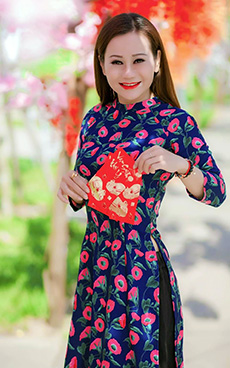 In 2003 Vietnam’s literacy rate (tỷ lệ biết đọc biết viết) was 94 percent, including 95.8 percent for men and 92.3 percent for women. However, educational attainment was less impressive (Tuy nhiên, trình độ học vấn kém ấn tượng hơn). Although five years of primary school education was considered compulsory (giáo dục tiểu học được coi là bắt buộc) and 92 percent of eligible children were enrolled in primary school in 2000, only two-thirds completed the fifth grade. The cost of tuition, books, and uniforms and the need to supplement family income are the two main reasons for dropping out. A huge disparity exists in primary school enrollment between the cities and rural parts of Vietnam (Có sự chênh lệch rất lớn về tỷ lệ tuyển học sinh tiểu học giữa thành phố và nông thôn Việt Nam). In some rural areas, only 10 to 15 percent of the children progress beyond third grade, whereas almost 96 percent of pupils in Ho Chi Minh City complete fifth grade. In 2000 enrollment in secondary school (trường cấp hai) was only 62.5 percent, much lower than in primary school (trường tiểu học). [Source: Facts and Details]
In 2003 Vietnam’s literacy rate (tỷ lệ biết đọc biết viết) was 94 percent, including 95.8 percent for men and 92.3 percent for women. However, educational attainment was less impressive (Tuy nhiên, trình độ học vấn kém ấn tượng hơn). Although five years of primary school education was considered compulsory (giáo dục tiểu học được coi là bắt buộc) and 92 percent of eligible children were enrolled in primary school in 2000, only two-thirds completed the fifth grade. The cost of tuition, books, and uniforms and the need to supplement family income are the two main reasons for dropping out. A huge disparity exists in primary school enrollment between the cities and rural parts of Vietnam (Có sự chênh lệch rất lớn về tỷ lệ tuyển học sinh tiểu học giữa thành phố và nông thôn Việt Nam). In some rural areas, only 10 to 15 percent of the children progress beyond third grade, whereas almost 96 percent of pupils in Ho Chi Minh City complete fifth grade. In 2000 enrollment in secondary school (trường cấp hai) was only 62.5 percent, much lower than in primary school (trường tiểu học). [Source: Facts and Details]
From 1918 until now, Vietnam’s education program has adopted the western educational system with three levels: elementary, high school, and college. At all levels, the Vietnamese National Writing (Quoc Ngu) is officially used. Students had (and still do have) the opportunity to learn literature, history, philosophy, law, science, math, medicine (văn học, lịch sử, triết học, luật, khoa học, toán học, y học) and as well as other languages. The first university that applied the western educational system was built in Northern Viet Nam, Hanoi, in 1919 (medicine school) and 1933 (law school). Toward 1975, the estimated population in Southern Viet Nam was 25 million people, but there were 3 state universities built in cities of Hue, Saigon, Can Tho. In parallel with the state universities, four private universities were also built: Three in Saigon were Van Hanh, Minh Duc, Tri Hanh Universities. One in Dalat was named after the city. They all offered various choices in curriculum (các lựa chọn khác nhau trong chương trình giảng dạy) similar to most modern universities around the world. In addition, each year thousands of Vietnamese students studied abroad (sinh viên du học) in countries such as the United States, France, Germany and Australia. Source: Vietnam-culture.
The Elite Girls School in Vietnam. Trưng Vương (Lycée Marie Curie) high school was founded in 1917 as Dong Khanh School and was at that time reserved for women. After the revolution of August 1945, the school was renamed Trung Vuong, the title given to the Trung sisters who fought against Chinese rule (*Trưng Vương, danh hiệu dành cho hai Bà Trưng đã chống lại ách thống trị của Trung Quốc) nearly 2,000 years ago. Completed with high walls and a huge wooden front gate. It was permeated by a strict air of discipline (Nó được thấm nhuần bởi một bầu không khí kỷ luật nghiêm ngặt), and the walls seemed designed to keep out the prying eyes of boys, so that sometimes, it could seem like a convent (tu viện). 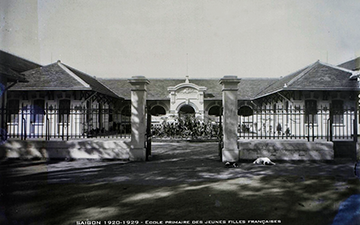 It sat at the end of a dead-end street, across from the zoo, and was surrounded by trees, flowers and a lot of nature. On the students that went there in the 1960s, Johnson wrote: “All are part of a Vietnamese elite, both educational and otherwise. Once upon a time, when the girls were small and nearing sixth grade, they had to pass rigorous tests and compete with thousands across the country to gain admittance. After they were accepted, many of their families relocated from other parts of Vietnam to live near the school — that's the kind of reputation Trung Vuong enjoyed. At least one of Kieu Thu's classmates was descended from Vietnamese royalty. Another was the daughter of the military's top official. The school has greatly contributed to the academic performance of Vietnam. For example, Hoang Le Minh, a student of Trung Vuong, became the first Vietnamese student to win a gold medal at the International Mathematical Olympiad (Toán học Quốc tế Olympic). Trung Vuong is also the alma mater of many Vietnamese scientists and officials (trường cũ của nhiều nhà khoa học và cán bộ Việt Nam) from central and Hanoi governments. On the occasion of the centenary of the founding of Trung Vuong School, highlighted in November 2017, National Assembly President Nguyen Thi Kim Ngan awarded the Order of Independence, First Class (Huân chương Độc lập, Hạng nhất), to teachers and to the students of the school.
It sat at the end of a dead-end street, across from the zoo, and was surrounded by trees, flowers and a lot of nature. On the students that went there in the 1960s, Johnson wrote: “All are part of a Vietnamese elite, both educational and otherwise. Once upon a time, when the girls were small and nearing sixth grade, they had to pass rigorous tests and compete with thousands across the country to gain admittance. After they were accepted, many of their families relocated from other parts of Vietnam to live near the school — that's the kind of reputation Trung Vuong enjoyed. At least one of Kieu Thu's classmates was descended from Vietnamese royalty. Another was the daughter of the military's top official. The school has greatly contributed to the academic performance of Vietnam. For example, Hoang Le Minh, a student of Trung Vuong, became the first Vietnamese student to win a gold medal at the International Mathematical Olympiad (Toán học Quốc tế Olympic). Trung Vuong is also the alma mater of many Vietnamese scientists and officials (trường cũ của nhiều nhà khoa học và cán bộ Việt Nam) from central and Hanoi governments. On the occasion of the centenary of the founding of Trung Vuong School, highlighted in November 2017, National Assembly President Nguyen Thi Kim Ngan awarded the Order of Independence, First Class (Huân chương Độc lập, Hạng nhất), to teachers and to the students of the school.
*In 40 CE, Trưng sisters lead revolt against Chinese domination trying to expel the Chinese but fail. (Their exploits and courage are legendary; Trưng Nhạc and Trưng Nhị were daughters of a local Lạc lord; they are believed to have committed suicide rather than submit to the Chinese.) afe.easia.columbia.edu
 VIETNAM’S BEST
VIETNAM’S BEST
CENTURY OLD HIGH SCHOOL. Being the first and also the oldest high school in Vietnam, originally Quốc Học in Central Vietnam (National high school) was the school for children from royal and noble families. Now it’s named Hue National High School and is a high-profile school that all students must pass a competititve entrance exam to get the admission. 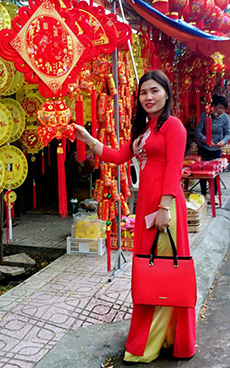 Vietnam Online]. Quốc Học Huế was established in 1896, bearing the style of the Nguyen Dynasty with its long walls, and it has a French style of red two-storey houses. The original name of the school was the École Primaire Supérieure meaning the Elementary College, but it was often called Quốc Học (1896-1936).
Vietnam Online]. Quốc Học Huế was established in 1896, bearing the style of the Nguyen Dynasty with its long walls, and it has a French style of red two-storey houses. The original name of the school was the École Primaire Supérieure meaning the Elementary College, but it was often called Quốc Học (1896-1936).
CHU VAN AN HIGH SCHOOL also known as Bưởi School (before 1945), is one of the oldest and most prestigious public schools (trường công lập lâu đời nhất và uy tín nhất) in Hanoi. Established by French colonial authorities in 1908 as High School of the Protectorate, this is one of the oldest institutions for secondary education in Indochina. [Source: vietnamnet.vn]. Tên chính thức lần lượt là Ecole d'Interprètes de Hanoi (1986-1904), Ecole Complémentaire de Hanoi (1904-1908), Collège du Protectorat (1908-1929), Lycée du Protectorat (1929-1945), Trường Trung Học Chu Văn An (1945-1975).
The first generation of Vietnamese female teachers was likely those who graduated from École Brieux. In 1913, the final examination of Franco-Vietnamese primary education took place in Hanoi and for the first time with the participation of girls. Some gained high score at the exam, above hundreds of boys. Soon after graduation they were appointed to be directors of feminine schools. Female teachers were mobilized from province to province like other male teachers, secretaries or clerks. In 1918, a section of training female teachers was founded in Dong Khanh school. In 1918, the Director of primary education in Tonkin circulated the updated program of Elementary schools, in which all subjects were the same for both boy and girl. The only difference was the lesson of manual work (thủ công), which provided boys with rudimental knowledge of work such as fishing, farming, carpentry, and girls with that of “feminine” work such as sewing, knitting, broidering, etc. Vietnamese placed a higher value on education rather than on material success. That the reason why parents encouraged their children to study and excel in their education. Vietnamese parents had a high regard for it which was considered as a way for family advancement.Vietnamese placed a higher value on education rather than on material success. That the reason why parents encouraged their children to study and excel in their education. Vietnamese parents had a high regard for it which was considered as a way for family advancement.Vietnamese placed a higher value on education rather than on material success. That the reason why parents encouraged their children to study and excel in their education. Vietnamese parents had a high regard for it which was considered as a way for family advancement.
WOMEN IN THE FAMILY
For centuries in Vietnam, traditional family values were accomplished by the fulfillment of traditional roles (vai trò truyền thống). Unlike Western culture that promotes individuality, to Vietnamese people, family is the most important aspect of life. Within a household hierarchy, the oldest male has the ultimate authority, responsibility, and final decision in all matters, followed by his eldest son. Since the highest status in Vietnamese families is given to the man or the father, he had absolute authority in the household (có quyền tuyệt đối trong gia đình). As he provided the main source of income, he was never expected to work in the kitchen or to cook. After work, he returned home and relaxed. As a head of household, he had the final decision in all matters. The father, however, had the duty to exercise restraint and wisdom in running his family in order to deserve his respected position. In a patriarchal society (xã hội gia trưởng), Vietnamese woman had limited rights and took a secondary place in family. Women were brought up according to a strict discipline (kỷ luật nghiêm ngặt) and have been traditionally less educated than men.
After marriage, woman became housewife and mother. She was expected to be depended upon her husband, took care of children and even grandchildren as well as performed all household tasks. A wife can be unhappy in her marriage, nevertheless, rather than accepts divorce; the family encouraged her to sacrifice and to endure the difficulties of the marriage for the sake of her children. Obedience and respect were the traditional virtues which Vietnamese children were taught to exhibit in their family. Discipline and physical punishment were acceptable remedies for disobedience. Boys and girls are not free to do what they want. Yet, girls are under strict supervision. Western style courtship and romance were seen as inappropriate things for unmarried children. As virginity is cherished, pregnancy out of wedlock is a grave disgrace to the family. For their children’s marriage, parents generally made decision because they could judge better. In the past, parents arranged marriage for their children (sometimes forced it on them), hence the saying: “Cha mẹ đặt đâu con ngồi đấy”. According to their belief, marriage has to be between people from the same background (môn đăng hộ đối).
As Western influence increased in Vietnam in 19th century, parents began to take more of an advisory role in the choice of their child’s mate, and arranged marriages are heavily declining. 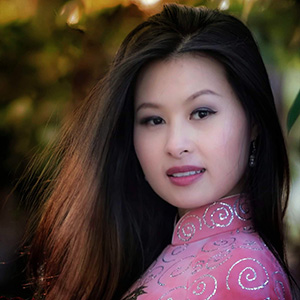 Parents are interested in securing a good mate for their child out of concern for their future. It is not unusual for parents to desire a mate of high status with a career that will be lucrative, such as doctor or lawyer. Currently, parents are more open to the choices of their child, and while they are consulted on the choice of partner, ultimately it is the child’s choice. Men usually married between 20 and 30 years of age, and women at 18 to 25 years of age. Women kept their maiden names legally but used their husband’s name formally.
Parents are interested in securing a good mate for their child out of concern for their future. It is not unusual for parents to desire a mate of high status with a career that will be lucrative, such as doctor or lawyer. Currently, parents are more open to the choices of their child, and while they are consulted on the choice of partner, ultimately it is the child’s choice. Men usually married between 20 and 30 years of age, and women at 18 to 25 years of age. Women kept their maiden names legally but used their husband’s name formally.
Divorce is considered shameful for the Vietnamese woman. Divorce is uncommon among Vietnamese in Vietname and United State, though in Vietnam the divorce rate is lower than in the U.S. This can partly be attributed to the values of a patriarchal society and that the notion of marrying for life is more pervasive. A man is considered responsible for his spouse until death. On the other hand, as a wife, a woman is expected to be a subservient, doting partner to her husband (Mặt khác, với tư cách là một người vợ, người phụ nữ được cho rằng là một người bạn đời ngoan ngoãn, dịu dàng với chồng mình). Vietnamese women are traditionally expected to put their families as the first priority, over any other things such as education, passion, or hobbies. However, there were already many cases that women had to take care of the family business when their husbands were immersed in debauchery. (những người chồng chìm đắm trong những cuộc ăn chơi trác táng)
How do Vietnamese show affections? Men and women do not show affection in public. However, members of the same sex may hold hands while walking. Always use both hands when passing an object to another person. Touching children on the head is only done by parents, grandparents, etc.
What is it like dating a Vietnamese girls? Vietnamese girls are very loyal, and they expect the same from you. However in my experience flirting is an important part of social interaction, and you're still expected to do it, even if you're dating. Tread lightly. With few exceptions Vietnamese people favor social conformity in a big way.
How do you know if a Vietnamese girl likes you? She glances your way, laughs at your jokes, and acts nervously around you. She'll usually tell you. She'll shower you with kindness. She'll bring you gifts. She'll be extremely excited to bring you into her family life. Is it easy to find a girlfriend in Vietnam? Be a good man that respects women. Respect her parents and siblings. Read the article and you will be able to look for your partner easily. These sites will help you finding friends, dating, making friends, and in the long run to find the perfect Vietnamese girl for yourself.
THE MOTHER ROLE
The role of the mother is highly valued in Vietnam culture. In some families, the mother is the head of the household and as matriarch, is the pillar of the home, the “trunk” of the family tree and is instrumental in keeping the family together. In Vietnam, the role of the mother in the family is highly honoured.  The strong matriarchal heritage of Vietnam dates back to the country’s early history when it women in Vietnam often took leadership positions with little opposition locally. Strong female leaders in Vietnamese history such as the famous warriors, the Trung Sisters and Trieu Thi Trinh played crucial roles in the preservation of the country. The impact that these women left influenced the way in which Vietnam appreciates the roles of women in society today.
The strong matriarchal heritage of Vietnam dates back to the country’s early history when it women in Vietnam often took leadership positions with little opposition locally. Strong female leaders in Vietnamese history such as the famous warriors, the Trung Sisters and Trieu Thi Trinh played crucial roles in the preservation of the country. The impact that these women left influenced the way in which Vietnam appreciates the roles of women in society today.
As a child, every Vietnamese had to learn at school the following poem by heart.
• Công cha như núi Thái Sơn (The good deeds of Father are as great as Mount Thai Son)
• Nghĩa mẹ như nước trong nguồn chảy ra (The virtue of Mother is as bountiful as springwater gushing from its source)
• Một lòng thờ mẹ kính cha (Wholeheartedly is Mother to be revered and Father respected)
• Cho tròn chữ hiếu mới là đạo con (So that the child’s way may be accomplished.).
The third line tells us that Mother is “to be revered and Father respected. We are all born, cared for and taught by our parents. It can be said that the merits that parents give to us up to now are great. Great parental love can not be replaced, even if it is wonderful nature. A mother's role is to love her children with all her heart. It is also the role of every mom to understand her children. When a child feels this, he or she learns to trust the mother(s) better. When a mother nurtures her children well, love and goodness are awakened in the children's hearts.
THE RICHEST WOMAN
A University of Oxford college is planning on changing its name to Thao College after receiving approximately $211 million from a Vietnamese investment Sovico group. Sovico established in the 1990s by a group of entrepreneurs, was represented by its chairwoman Nguyen Thi Phuong Thao. Sovico Group focuses on development with the mission of providing financial, banking, aviation, real estate and industrial products and services of international quality and standards to satisfy the needs of customers. products, making practical contributions to the development of economic integration. Nguyen, the founder of Vietjet Air, is one of Asia's self-made female billionaires. She is considered to be the richest woman in Vietnam, according to the Bangkok Post. Linacre College announced the news on their website on November 1st, 2021 and cited plans to create a new graduate building and offer more graduate scholarships. Founded in 1962, the graduate college was named after Thomas Linacre, a 15th century humanist, medical scientist and classicist. Linacre College is one of 36 constituent colleges at the University of Oxford.

